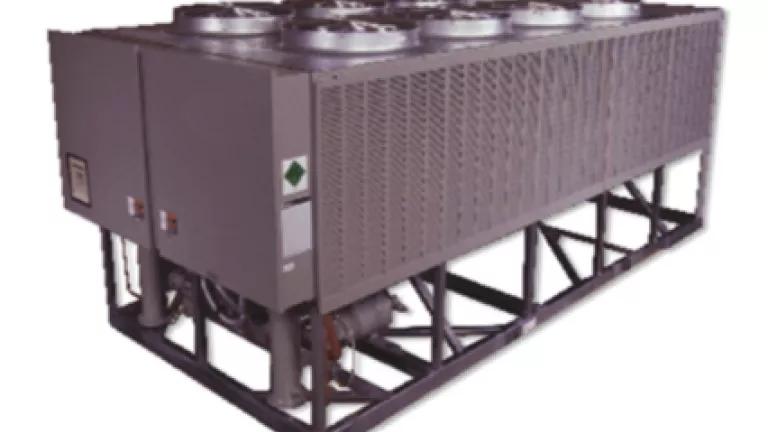Cooling With Less Warming: NRDC, Manufacturers Agree on Phasing Out HFC Super-Pollutants in Building Chillers

This post coauthored with Alex Hillbrand
NRDC and the Air-Conditioning, Heating, and Refrigeration Institute (AHRI) agreed yesterday on a schedule for eliminating the use of super-potent climate-warming chemicals called hydrofluorocarbons (HFCs) in building water "chillers" - the air conditioning equipment used to cool most large buildings and also used in a variety of industrial processes.
The agreement with AHRI, the trade group of leading chiller manufacturers, will secure a big reduction in climate-warming emissions from a major class of cooling equipment, while creating incentives for the most energy-efficient, climate-friendly refrigerants and equipment designs.
Traditional Air Cooled Chiller (photo courtesy of Ingersoll Rand)
The NRDC/AHRI agreement, delivered yesterday to the Environmental Protection Agency, contains a joint recommendation that EPA set a deadline of 2025 for eliminating use of three HFC-containing refrigerants (R-134a, R-410A, and R-407C) in new chillers of all types and sizes. These range from small, packaged "scroll" rooftop chillers to large, custom-built "centrifugal" chillers in machine rooms or industrial facilities.
Carrying out one of the Obama administration's major climate protection initiatives, EPA is preparing regulations under the Clean Air Act's "Significant New Alternatives Policy" (SNAP) Program with deadlines for ending use of HFCs in applications where safer alternatives are available. EPA issued a first-round SNAP rule in July 2015. The second SNAP rule will cover more categories of equipment, including chillers, and will be proposed and finalized this year.
Chillers are commonly used to cool medium-sized and large commercial buildings. Currently, however, they rely on potent climate-warming HFCs that, themselves, vary in energy efficiency. Today's agreement sets a schedule for eliminating these heat-trapping HFCs from new chillers, opening the door to new refrigerants with significantly higher energy efficiency. New refrigerants with greater energy efficiency will mean that chillers consume less power, producing less carbon pollution at the power plant.
NRDC petitioned EPA last year to complete the phase-out of R-134a, R-410A, and R-407C in new chillers by 2023. The manufacturers favored longer timelines, ending as late as 2030 for some types of equipment. Our agreement allows companies eight years to redesign their entire product lines, but both the industry and NRDC expect that many companies will start introducing new equipment with climate-friendlier refrigerants well before 2025.
The agreement also makes it more likely that manufacturers will move to refrigerants with near-zero heat-trapping potency and the highest energy efficiency, such as R-1234ze and R-1233zd, rather than adopting middle-range potency refrigerants such as R-513A and R-450A. The latter refrigerants (blends of low-potency hydrofluoroolefins (HFOs) with high-potency HFCs) have lower energy efficiency, lower cooling capacity, and higher heat-trapping potency than pure HFOs.
The agreement also helps ensure that EPA will ban all three high-potency refrigerants in all classes of chiller equipment. Chillers range widely in size, refrigerant, and technology, and industry's willingness to redesign even their most complex chillers within eight years is a strong indicator of their support for our shared climate goals.
By setting a single deadline, the agreement allows industry members to chart their own course to climate-friendlier product portfolios, while assuring product safety and manageable transition costs.
Our agreement comes as countries work toward an international agreement to phase down HFCs under the Montreal Protocol. The steps that the U.S. takes to phase down HFCs under the Clean Air Act give other countries confidence in our country's intentions, and help assure that American companies will lead the production of climate-friendly, energy-efficient products worldwide. By supporting our diplomatic efforts abroad with strong action at home, NRDC and AHRI hope to boost prospects for a strong Montreal Protocol agreement later this year.

